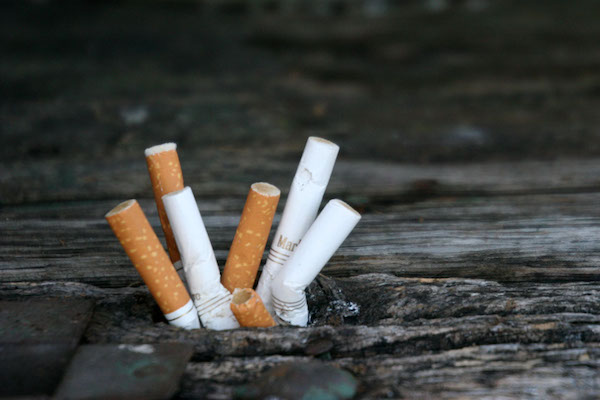
[Image above] Credit: Dennis Hill; Flickr CC by 2.0
We’re drowning in cigarette butts. Even us non-smokers.
According to the Cigarette Butt Pollution Project (CBPP), 360 billion cigarettes are sold in the U.S. every year. Nearly a third of those (120 billion) are tossed on the ground and into the waterways.
According to the CBPP’s report, “The Environmental Impact of Cigarette Butt Waste: Just the Facts,” cigarette butt waste is not only toxic to human and animal life, it’s also not biodegradable. Which means all that tar and nicotine trapped in the filters is leaching into the environment, lingering until the end of time.
I remember several years ago when I participated in Kick Butt Columbus, how time consuming it was to pick up individual cigarette butts from the roadside. And we were just volunteers. I can only imagine what it would cost to pay city workers to do the same thing. A 2009 San Francisco tobacco litter study found that the city spent over $7 million in one year to clean up discarded cigarette butts.
As long as people continue to think that the world is their ashtray, we will probably make very little progress in ridding the environment of these little polluters.
However, scientists at RMIT University are making good use of discarded butts. A team led by Abbas Mohajerani, RMIT senior lecturer, has figured out a way to make stronger asphalt pavement by mixing in cigarette butts. They found that encapsulating the butts in paraffin wax and bitumen, a liquid binder, prevents chemicals in the cigarette butts from seeping into the asphalt.
And once the material is used in pavement, the research team found it could not only handle heavy traffic, but it also reduced heat generated from the sun beating down on black asphalt—an effect known as the urban heat island effect.
In their paper, the authors describe two experiments—one that analyzes effects of using different amounts of cigarette butts encapsulated with different classes of bitumen mixed with asphalt concrete made with class 170 bitumen. In the other study, they analyzed the results of mixing 10 kg/m3 of cigarette butts—encapsulated in paraffin wax only—into asphalt concrete made with class 170 and class 320 bitumen.
After conducting various tests on the samples, they determined that the butts encapsulated with bitumen and mixed with class 170 bitumen provided better results for handling heavy traffic than the paraffin-encapsulated butts mixed with c170 and c320 bitumen. The paraffin-encapsulated butts were only able to support light traffic conditions.
This isn’t the first time Mohajerani has experimented with cigarette butts. Last year his team demonstrated that incorporating butts into clay bricks reduced the energy needed to fire the bricks by up to 58%.
“Encapsulated cigarette butts developed in this research will be a new construction material which can be used in different applications and lightweight composite products,” Mohajerani says in RMIT University’s news release. “This research shows that you can create a new construction material while ridding the environment of a huge waste problem.”
Their paper, published in Construction and Building Materials, is “Physico-mechanical properties of asphalt concrete incorporated with encapsulated cigarette butts” (DOI: 10.1016/j.conbuildmat.2017.07.091.
